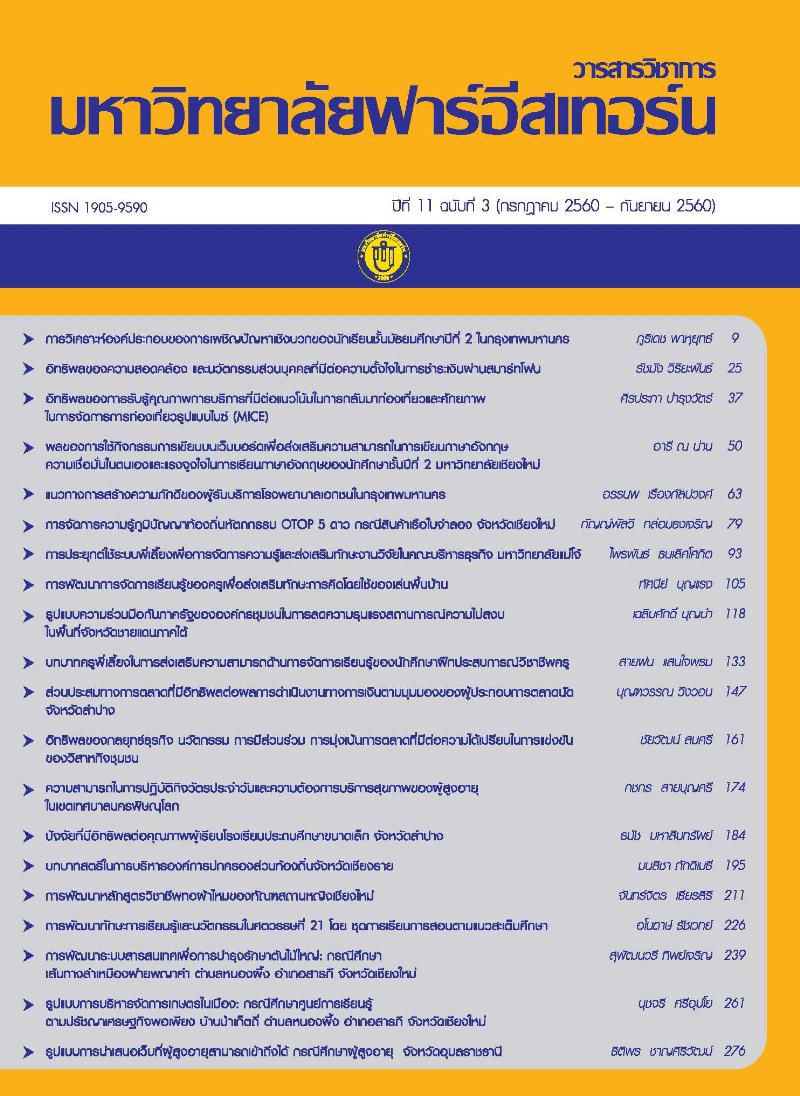อิทธิพลของกลยุทธ์ธุรกิจ นวัตกรรม การมีส่วนร่วม การมุ่งเน้นการตลาดที่มีต่อความได้เปรียบในการแข่งขันของวิสาหกิจชุมชน จังหวัดลำปาง
Main Article Content
Abstract
การวิจัยเชิงปริมาณครั้งนี้มีวัตถุประสงค์เพื่อศึกษาระดับความสำคัญของกลยุทธ์ธุรกิจ นวัตกรรม
องค์กร การมีส่วนร่วม การมุ่งเน้นการตลาด และความสามารถในการแข่งขันของวิสาหกิจชุมชน ตลอดจน
ปจั จัยทมี่ อี ทิ ธิพลตอ่ ความสามารถทางการแขง่ ขันของวิสาหกิจชุมชน กลุม่ ตัวอยา่ งเปน็ ผูป้ ระกอบการวิสาหกิจชุมชน
ที่มีผลการดำเนินงานในระดับดีของจังหวัดลำปาง จำนวน 165 ราย สุ่มตัวอย่างแบบอย่างง่าย เครื่องมือ
ในการวิจัยเป็นแบบสอบถาม และสถิติที่ใช้ในการวิเคราะห์ข้อมูล ได้แก่ ร้อยละ ค่าเฉลี่ย ส่วนเบี่ยงเบน
มาตรฐาน สัมประสิทธิ์สหสัมพันธ์ และการวิเคราะห์การถดถอยเชิงพหุคูณ ผลการวิจัยพบว่า วิสาหกิจชุมชน
ใหค้ วามสำคัญทุกปจั จัยอยูใ่ นระดับมาก โดยเรียงลำดับจากมากไปหานอ้ ยดังนี้ ความไดเ้ ปรียบทางการแขง่ ขัน
การมุ่งเน้นการตลาด นวัตกรรม การมีส่วนร่วม และกลยุทธ์ธุรกิจ ส่วนการศึกษาปัจจัยที่มีอิทธิพลต่อ
ความได้เปรียบทางการแข่งขันของวิสาหกิจชุมชนในจังหวัดลำปาง พบว่า ปัจจัยที่มีอิทธิพลต่อความได้เปรียบ
ทางการแข่งขัน ประกอบด้วย กลยุทธ์ธุรกิจ นวัตกรรม การมีส่วนร่วม โดยปัจจัยที่มีอิทธิพลมากที่สุด
ได้แก่ นวัตกรรม รองลงมาคือ การมีส่วนร่วม สำหรับปัจจัยที่มีอิทธิพลน้อยที่สุดคือ กลยุทธ์ธุรกิจ
The purpose of this quantitative research was to study the levels of business strategic
importance, organizational innovation, participation, market orientation and competitive advantage,
including factors affecting the competitive ability of community enterprise. One hundred and sixty
five entrepreneurs, whose works at a good operational level in Lampang, were employed as sample
in this study with simple random sampling technique. Research instrument was a questionnaire
and these statistics were analyzed: percentage, mean, standard deviation, correlation coefficient
and multiple linear regression analysis. Research results were found that community enterprise
gave the importance of all aspects at a high level, ranking from high to low level as follows:
competitive advantage, market orientation, innovation, participation, and business strategy. In
addition, the studying of factors affecting the competitive advantage of community enterprise at
Lampang province, it was found that factors affecting the competitive advantage consisted of
business strategy, innovation, participation. Most crucial factor was as innovation, following by
participation. However the less crucial factor was as business strategy.
Article Details
1. Any views and comments in the Journal of Social Innovation and Lifelong Learning are the authors’ views. The editorial staff have not to agree with those views and it is not considered as the editorial’s responsibility.
2. The responsibility of content and draft check of each article belongs to each author. In case, there is any lawsuit about copyright infringement. It is considered as the authors’ sole responsibility.
3. The article copyright belonging to the authors and The Far Eastern University are copyrighted legally. Republication must be received direct permission from the authors and The Far Eastern University in written form.
References
ไกรวิทย์ เศรษฐวนิช. (2548). ความล้มเหลวที่ SMEs ต้องแก้ไข. กรุงเทพฯ: ซีเอ็ดยูเคชั่น.
ชัยยุทธ เลิศพาชิน. (2554). กลยุทธ์สําหรับการเป็นผู้ประกอบการยุคใหม่ภายใต้ประชาคมเศรษฐกิจอาเซียน. วารสารสังคมศาสตร์วิชาการ. 6 (1).
บุญฑวรรณ วิงวอน. (2550). การจัดการธุรกิจขนาดย่อม. ลำปาง: สาขาวิชาการจัดการทั่วไป คณะวิทยาการจัดการมหาวิทยาลัยราชภัฏลำปาง.
ระบบสารสนเทศวิสาหกิจชุมชน (2558). รายงานการยื่นจดทะเบียนวิสาหกิจ/เครือข่ายวิสาหกิจชุมชน. ค้นเมื่อ 18 มกราคม 2559, จาก http://smce.doae.go.th/smce1/report/report_svc01.php.
วิทูร เจียมจิตต์ตรง. (2553). ปัจจัยภาวะผู้ประกอบการที่มีต่อผลประกอบการของวิสาหกิจขนาดกลางและขนาดย่อม. ดุษฎีบัณฑิตรัฐประศาสนศาสตร์ สถาบันบัณฑิตพัฒนบริหารศาสตร์.
สำนักงานวิสาหกิจขนาดกลางและขนาดย่อม. (2554). รายงานสถานการณ์ SMEs ประจําปี 2556.ค้นเมื่อ 8 มีนาคม 2557, จาก http:/www.sme.go.th.
Afzal, S. (2010). Marketing capability, strategy and business performance in emerging markets of Pakistan. IUB Journal of Social Sciences and Humanities. 7(2), 88-102.
Barney, J. (1991). Firm resource and sustained competitive advantage. Journal of Management. 17(1), 99-106.
Boone, L.E., & Kurtz, D.L. (2010). Contemporary business. (13th ed.). New York: John Wiley & Sons.
Bygrave, W.D., & Hofer, C.W. (1991). Theorizing about entrepreneurship. Entrepreneurship Theory and Practice. 16(2), 13-22.
Casey, D. (1996). Managing learning organizations. Buckingham: Open University Press.
Cronbach, L.J. (1951). Coefficient alpha and the internal structure of tests. Psychometrika. 16, 297-334.
Day, G.S., & Wensley, R. (1988). Assessing advantage: A framework for diagnosing competitive superiority. Journal of Marketing. 16(1), 7-27.
Drucker, E.P. (1985). The discipline of innovation. Harvard Business Review. 67-72.
Drucker, P.F. (1985). Innovation and entrepreneurship: Practice and principles, Harvard Business Review. 76 (6), 149-157.
Gibbons, A. (1997). Innovation and the developing system of knowledge production, University of Sussex.
Hair, J.F., Black, C., Willium, B., Barry, J., Anderson, R.E., and Tatbam, R.L. (2006). Multivariate data analysis. New Jersey: Pearson Edudation.
Harris, L.C., & Ogbonna, E. (2001). Strategic human resource management, market orientation, and organizational performance. Journal of business research. 51(2), 157-166.
Hidayato, A.N., & Setyady, S.T. (2014). Impact of collaborative tools utilization on group performance in University students. TOJET: The Turkish Online Journal of Educational Technology. 13(2), 88-98.
Hyvarinen, L. (1990). Innovativeness and its indicators in small and medium-sized industrial Enterprises. International Small Business Journal. 9(1), 64–74.
Jia-Sheng Lee & Chia-Jung Hsieh. (2010). A research in relating entrepreneurship, marketing capability, innovative capability and sustained competitive advantage. Journal of Business
and Economics Research. 8(9), 109-120.
Kircar, A.H. ,Jayachandran, S., & Bearden, W.O. (2005). Market Orientation: A meta-analytic review and assessments and impact on performance. Journal of marketing. 24-41.
Kohli, A.K., and Jaworski, B.J. (1990). Market orientation: The construct, research propositions, and managerial implications. Journal of Marketing. 54(2), 1–18.
Kumar, K.R., Subramanian, and Yauger, C. (1998). Examining the market orientation-performance relationship: A context-specific study. Journal of Management. 24(2), 201–233.
Kuratko, D.F., & Hodgetts, R.M. (2004). Entrepreneurship: Theory, process, practice. Mason, OH: South-Western Publishers.
Likert, R.N. (1970). A technique for the measurement of attitude. Attitude Measurement. Chicago: Ronal McNally & Company.
Megginson, L.C., Byrd, M,J., & Megginson, W.L. (2003). Small business management: An entrepreneur’s Guide Book. New York: McGraw-Hill.
Peters, T.J., & Waterman, R.H. (1982). In search of excellence: Lessons from America’s best-run companies. New York: Harper & Row.
Porter M.E. (1998). On competition. A Harvard Business Review book series. Boston, MA: Harvard Business School Publishing.
Porter M.E. (1985). Competitive strategy: Techniques for analyzing industries and competitors, New York, NY: The Free Press.
Porter, M.E. (1990). Competitive advantage: Creating and sustaining superior performance, New York, NY: The Free Press.
Rothwell, R. (1992). Successful industrial innovation: Critical factors for the 1990s. Research and Development Management. 22(3), 221–239.
Schumpeter, J.A. (1934). The theory of economic development. New York: Oxford University Press.
Smith, David. (2006). Exploring innovation. Berkshire: McGraw-Hill Education.
Wingwon, B. (2010). Antecedents of PLS path model for competitive advantage and financial performance of SMEs in Thailand. African Journal of Marketing Management. 2(6), 123-135.

